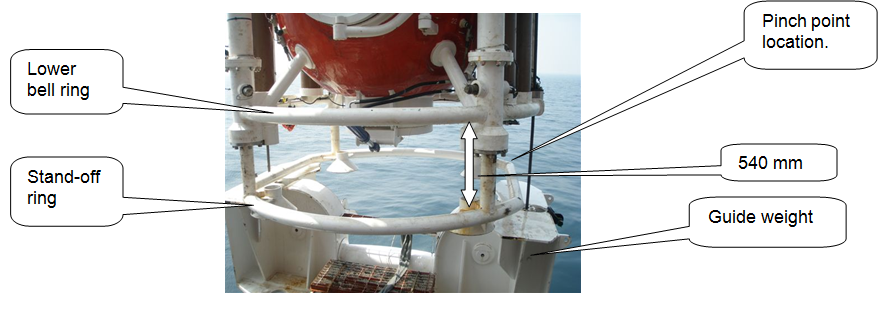Near-miss: Saturation diver lost gas supply
A member has reported a near-miss incident in which a saturation diver on the seabed lost reclaim and immediately thereafter, lost his main gas supply. The incident occurred during pipeline free span correction measurements at a depth of 100m. The diver made his way back to the bell on emergency gas, and while doing so, requested ‘up on my hose’. However no such action followed. Slightly over a minute and a half later the diver had made his way unassisted back to the bell on emergency gas. As he passed by the bell stand-off ring he became aware that his hose was trapped between the stand-off ring and the guide weight. Once the diver was inside, the bell was raised and the umbilical retrieved and inspected for damage. The diver was unharmed.
An investigation revealed the following causal factors:
- There was no written procedure for setting the bell directly on the guide weight during dives;
- Egress from the bell was between the guide weight and the stand-off ring rather than between the stand-off ring and the lower bell ring;
- In-boarding of the bell launch and recovery system (LARS) resulted in a decrease in the gap between the guide weight and the stand-off ring which subsequently trapped the excursion umbilical to the extent that gas flow through all lines was interrupted. A video image of the gap area was available at the control panel of the LARS but not in dive control.
It was noted that the following things went right:
- The diver, upon informing his supervisor of the loss of gas, immediately went on emergency gas and started to return to the bell;
- The supervisor immediately provided secondary gas from dive control and advised the diver accordingly. Gas to the pneumo-fathometer was also established within seconds;
- The stand-by diver checked and announced full pressure from the bell immediately upon learning that the diver was on emergency gas;
- The incident was recorded and retained on the DVD for review and use as historical evidence and training;
- Timely initial advice, incident notifications and follow up documentation to required parties were in place;
- Everyone reacted to the event in a quiet and professional manner without panic.

The following actions were taken and recommendations made:
- A stand down and investigation was initiated prior to continuing diving operations;
- An enquiry was made to the system manufacturer as to the intended method of entry and exit from the bell1. It was confirmed that the normal route was between the stand-off ring and the lower bell ring. The use of twin 12 litre cylinders with flotation attached impeded access through the designed route (540 mm). The bottom hatch opening is itself 700 mm. It was further agreed that the space limitation would compound matters in the performance of a rescue dive. For this reason the route chosen was not altered for the remainder of the project;
- Investigation as to the feasibility of modifications to increase the gap to 800 mm are on-going with the manufacturer and the owner;
- For subsequent dives a sign was posted at the LARS control console advising landing of the bell upon the guide weight while divers are locked out, with reminder to confirm with the Supervisor prior to any movement of the launch equipment while diving. A statement to this effect was included in written procedures and communicated throughout the company;
- Letters of recognition were presented to key individuals involved on the matter of a successful and well performed recovery.
1 – Our member’s policy on guide weight/bell interface position while diving is to set the bell on the guide weight in order to eliminate the pinch point. This may be adhered to as a general approach however there may be cases where this is less than desirable such as with ‘light’ bells or excessive heave. An assessment should be done on a case by case basis accordingly. Such an assessment should consider the optimum position required for an emergency rescue.
Safety Event
Published: 25 June 2012
Download: IMCA SF 06/12
IMCA Safety Flashes
Submit a Report
IMCA Safety Flashes summarise key safety matters and incidents, allowing lessons to be more easily learnt for the benefit of all. The effectiveness of the IMCA Safety Flash system depends on Members sharing information and so avoiding repeat incidents. Please consider adding [email protected] to your internal distribution list for safety alerts or manually submitting information on incidents you consider may be relevant. All information is anonymised or sanitised, as appropriate.
IMCA’s store terms and conditions (https://www.imca-int.com/legal-notices/terms/) apply to all downloads from IMCA’s website, including this document.
IMCA makes every effort to ensure the accuracy and reliability of the data contained in the documents it publishes, but IMCA shall not be liable for any guidance and/or recommendation and/or statement herein contained. The information contained in this document does not fulfil or replace any individual’s or Member's legal, regulatory or other duties or obligations in respect of their operations. Individuals and Members remain solely responsible for the safe, lawful and proper conduct of their operations.
